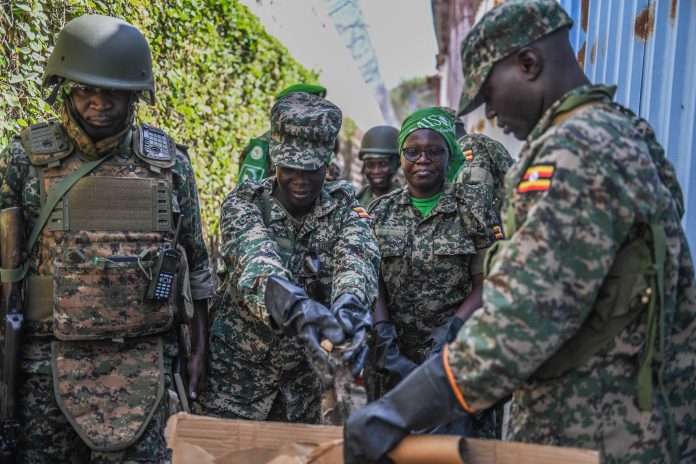For the past 17 years, African Union (AU) troops have been in Somalia. They arrived in 2007 under a mission called AMISOM, which later became ATMIS, with the goal of helping Somalia defeat al-Shabaab, rebuild its government, and bring peace to the country. Many Somalis welcomed this effort with hope. But now, nearly two decades later, Somalia remains unstable. Al-Shabaab is still active. Millions still live in insecurity. The mission has not delivered peace. This leads to an important question: why did AU troops fail?
The answer is clear. The mission was not truly built to help Somalia. It became a tool for foreign governments and armies to benefit themselves. For many of the Troop Contributing Countries (TCCs), Somalia turned into a platform to gain political, military, and economic rewards from international donors like the United States, the European Union, the United Kingdom, and the United Nations. It was not about ending the war—it was about keeping the war going just enough to stay relevant and keep the funding flowing.
One of the clearest examples of this self-serving behavior is how the TCCs used their involvement in Somalia to promote their own national interests and strengthen foreign alliances. They used the mission to justify military expansions in their own countries under the excuse of fighting terrorism. They received military equipment, training, and millions of dollars in financial assistance. These rewards weakened their desire to end the conflict. Why end a war that keeps bringing money, weapons, and diplomatic influence?
Some even went further by awarding direct contracts to private companies from their own countries for logistics support—fuel, food, transportation, and uniforms—profiting from the mission in silence. Somalia, in this way, was treated more like a business opportunity than a place that needed peace.
Because of this self-interest, many AU forces did not fully engage. Troops often stayed inside fortified bases in cities like Mogadishu. They rarely operated in rural areas, where al-Shabaab had strong control. This allowed the group to maintain influence, collect taxes, and terrorize communities. Instead of weakening al-Shabaab, the mission ended up giving the group room to survive.
The AU mission was also poorly coordinated. Different countries operated under different chains of command. Uganda followed Uganda. Burundi followed Burundi. Ethiopia followed its own plan. There was no unified strategy. Somali security officials were often left out of planning. The mission was supposed to support Somalia’s national security, but in practice, it often sidelined Somali leadership and created dependency instead of strength.
Even when AU troops liberated towns from al-Shabaab, they failed to hold them or bring stability. There were no schools built, no hospitals opened, no working administration supported. After AU forces left, al-Shabaab would return. This cycle repeated itself for years. The mission focused on short-term military operations but never created long-term peace or development.
Worse still, in some cases, AU forces caused harm. There were reports of civilian casualties, corruption, theft, and even deals with al-Shabaab. Some soldiers were accused of selling fuel and weapons on the black market. Others turned a blind eye to illegal activities. Very few were held accountable. This damaged the mission’s image among Somalis and reduced public trust.
Now, a new phase is beginning. The African Union is replacing ATMIS with a new mission called AUSSOM—the African Union Support and Stabilization Mission in Somalia. This mission is supposed to support Somalia’s transition and final security handover. But already, AUSSOM faces a major setback: the United States has refused to fund it.
Despite the United Nations Security Council approving support for AUSSOM, the U.S. government said it is not ready to allocate funds for the new mission. American officials expressed frustration over past financial contributions to ATMIS and AMISOM, which they say produced few results. They pointed to the lack of meaningful progress against al-Shabaab and questioned the effectiveness of AU-led operations. This decision sends a clear message: even donors no longer believe in the way these missions have been run.
This lack of international support is a result of years of failure, mismanagement, and self-interest. It proves what many Somalis have known for a long time—that the AU mission lost its purpose. It was never truly about Somalia’s peace. It became about money, influence, and survival for foreign armies and politicians.
This is a painful truth. But we must face it if we want to move forward. Somalia cannot rely on foreign troops to fix its problems. Only Somalis can rebuild Somalia.
We need a professional and united national army. We need inclusive local governments. We need jobs, justice, education, and roads. We need a new political culture that serves citizens, not clans or foreign interests. And we need leadership that puts Somalia’s future above everything else.
Some AU soldiers served with courage. Some gave their lives. Their sacrifices are not forgotten. But the mission as a whole failed because it was not designed to succeed in the first place.
It is now time for Somalia to take full control. We must break the cycle of dependency and foreign-led solutions. The world cannot build our peace. That responsibility belongs to us.


